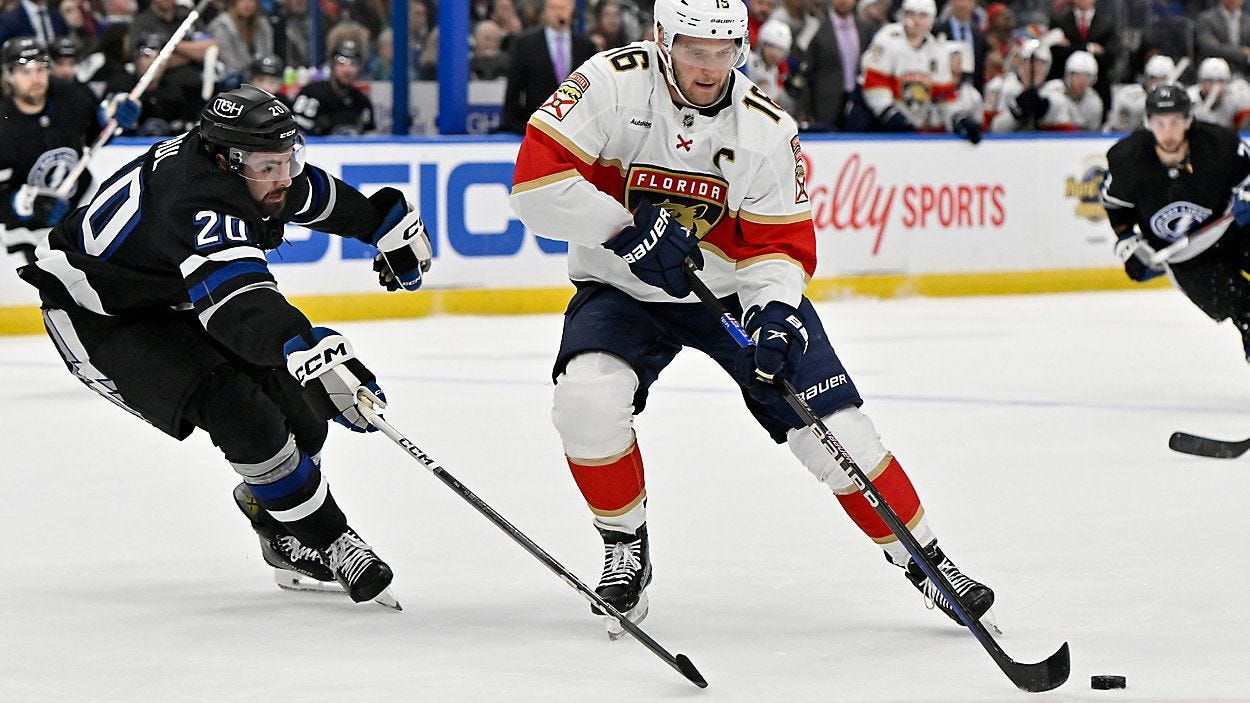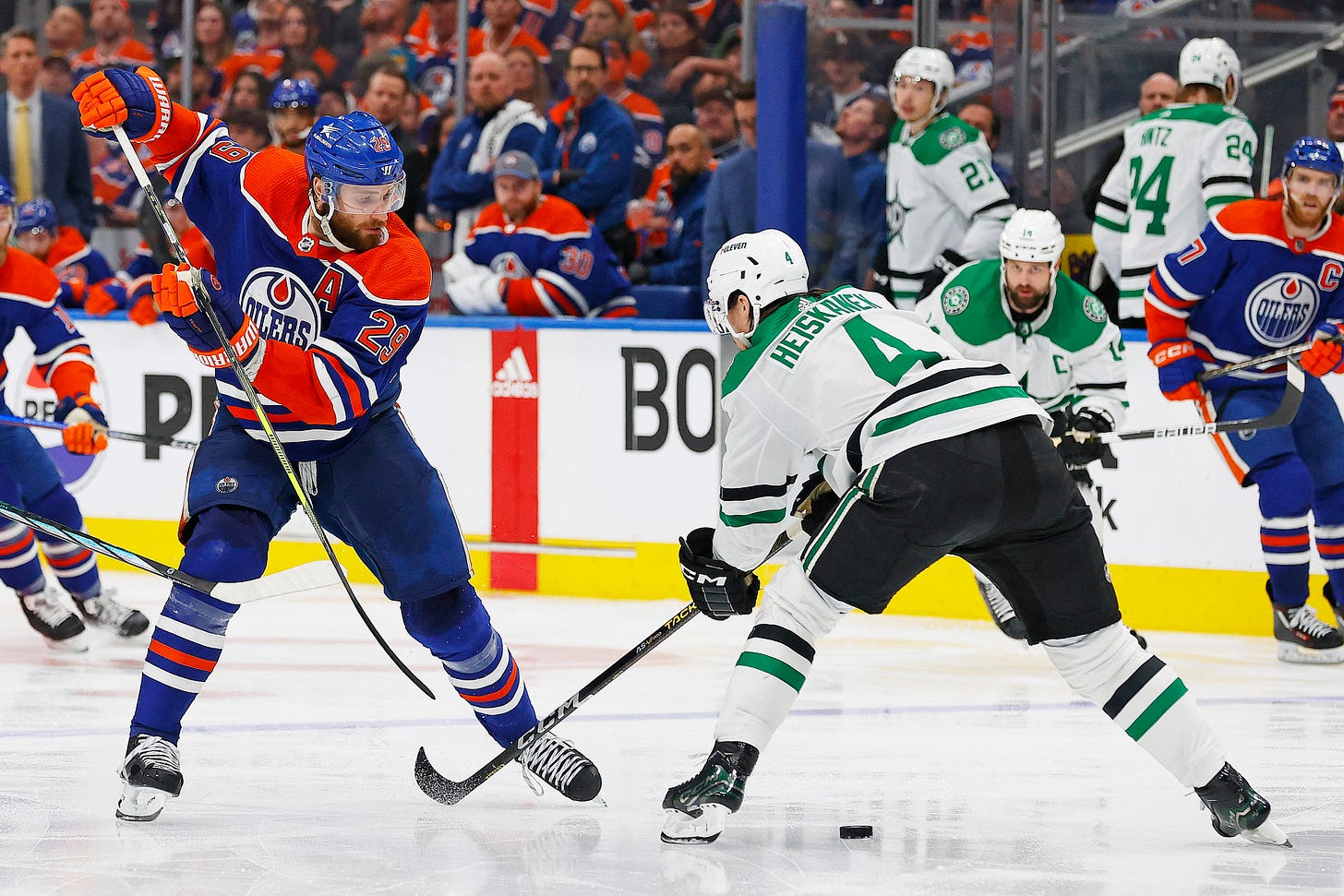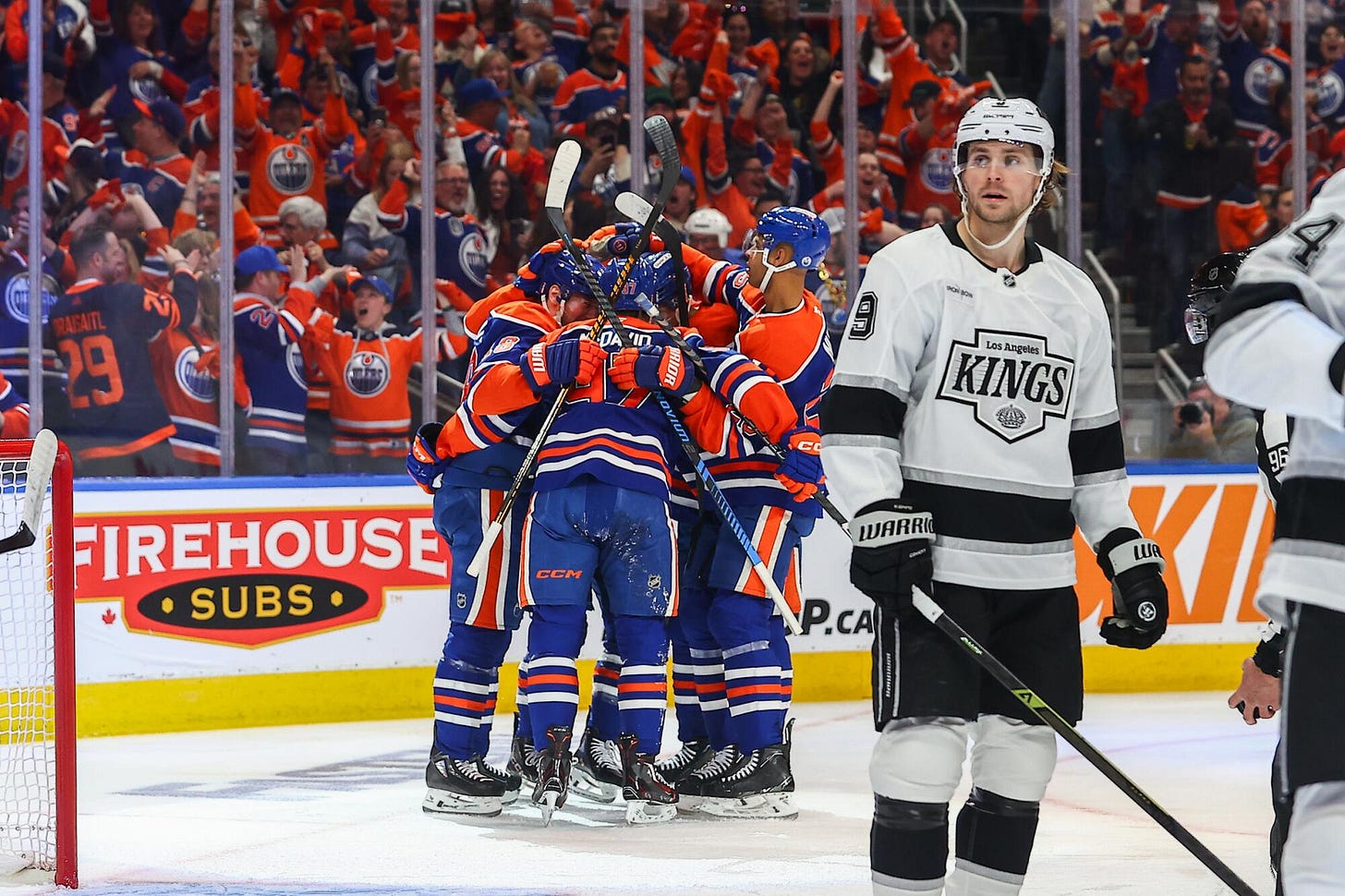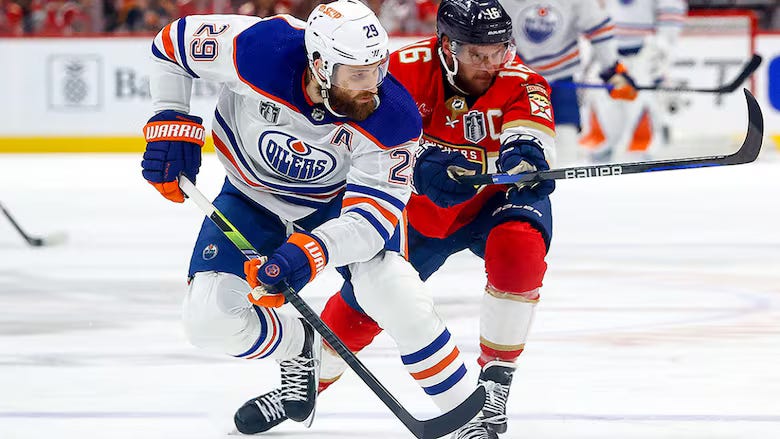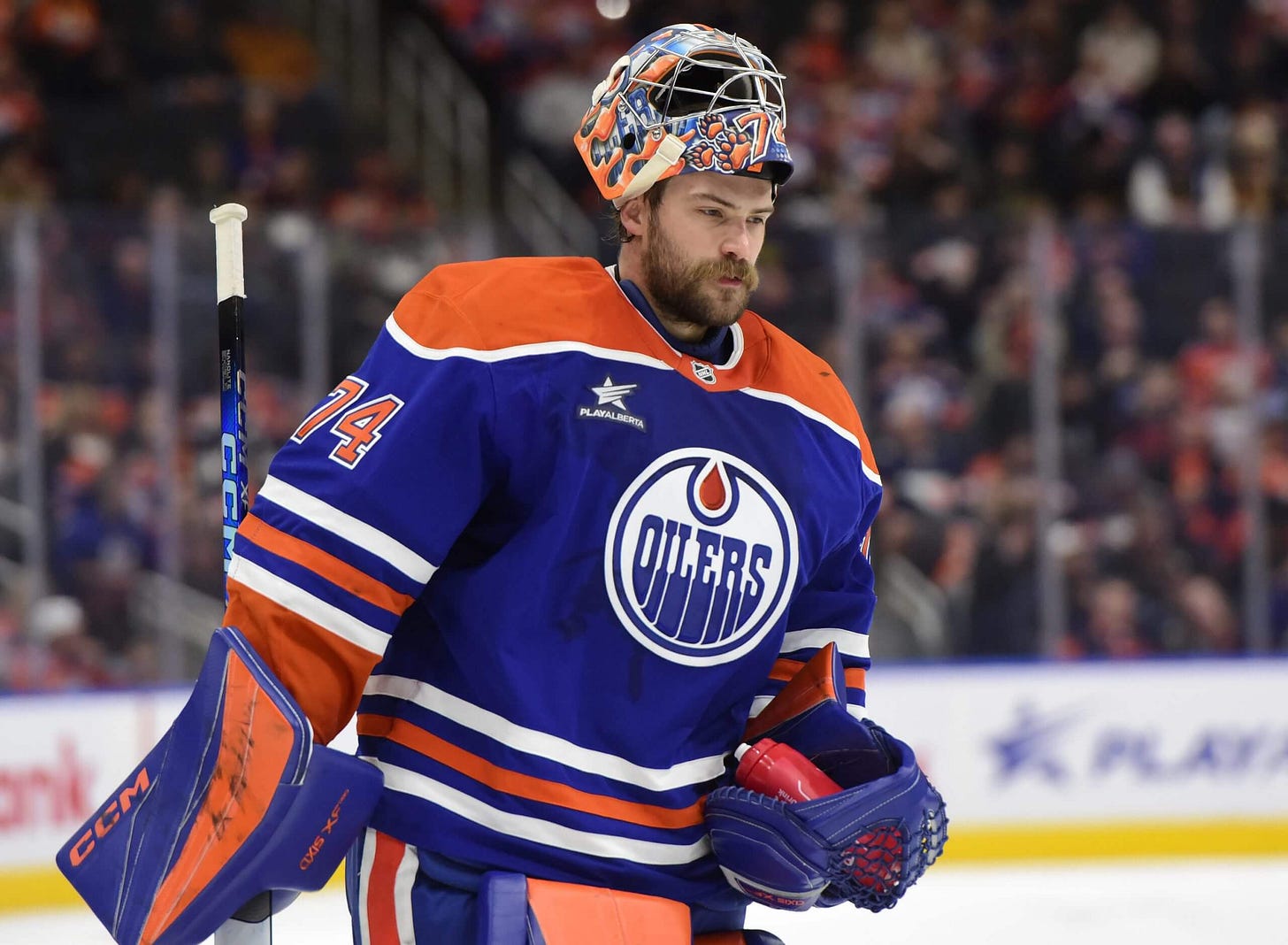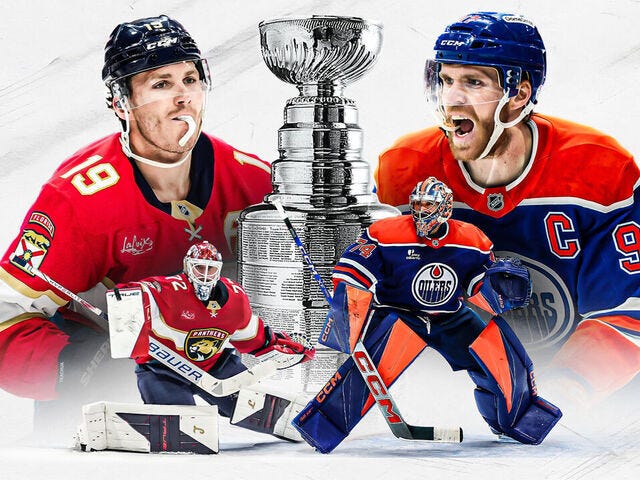Back in mid-April I published an unorthodox preview for the 2025 Stanley Cup Playoffs, handing out “most likely to” superlatives to all 16 playoff teams. Some were lighter and more satirical, others more detailed and amounted to what were basically predictions. Some went decently well. Others, including the two teams I had in the Stanley Cup Final, did not do so well.
With most of the playoffs in the books, as we now know that it will be the Edmonton Oilers vs. Florida Panthers for the Stanley Cup (again), I thought it wouldn’t be a bad time to revisit my preview. Like any honest analyst, I want to show my process and the lessons I am learning along the way, while also acknowledging things I got right. Today I’m going to do it all with a series of takes and debriefings about what I learned from the 2025 playoffs and then will wrap it up with some takes on the upcoming rematch in the Stanley Cup Final:
Ignore history because we are in an age lacking parity
If there’s one mistake I’ve made too often in the last few years of predictions, it’s looking at history to identify trends in the present. Part of that is because I love hockey history and there are general patterns that tell stories. It’s just that in this case, the stories they tell are how historically great the Tampa Bay Lightning and Florida Panthers have been in the last half-decade and how anomalous their dominance has become.
Back in 2022 I was picking against the Lightning going deep again largely because it had been since the mid-1980s that any team went to three straight finals and I figured that with the condensed playoff schedule of 2020/21, Tampa was likely to break down at some point. It didn’t happen, the Lightning moving past the Leafs in a grueling seven game series before sweeping Florida and then reversing the tide to rally against the Rangers and make a third straight finals appearance. To me that was the clearest sign of how legendary the Lightning were, doing something that the dynasty Red Wings, Penguins (both eras), Devils, and Blackhawks never could.
Naturally, I didn’t think it would happen again so soon. After going 35 years since any team went to three straight finals, we’ve now had two teams do it back to back in the same conference, Tampa 2020-22 and Florida 2023-25 (Edmonton will have a chance to do it in 2026). This year again I fell for the trap of “playoffs are so hard and against really good teams, this team who has played a ton of hockey with two recent deep playoff runs will get ground down” logic. I thought Tampa Bay could be that team who would grind down the Panthers in a long series this year and then were poised to go on a run after that, which is why I picked them to go play in the finals. Nice try!
I don’t think the Lightning played as well as they could have in that series, with Andrei Vasilveskiy’s start and end to the series being very disappointing. But I also think this version of the Panthers was clearly better than Tampa (especially with the Bolts’ top trade deadline acquisition Oliver Bjorkstrand injured) and that showed in this series. More punishing on defense and far deeper at forward, with a goalie who has had much more playoff success as of late. That was apparent to me on paper before the playoffs but I did not trust my eyes and go off of raw talent, instead concocting an argument based too much on history and patterns in picking the Lightning.
[Jason Behnken/AP Photo]
Likewise, I read too much into the end of the regular season. I pride myself on being someone who actually watches the games and examines the data, rather than relying on worn-out narratives. Watching the games and taking note of what you see is better than not paying attention and relying on familiar narratives to explain results, but certain NHL teams (say, the Panthers) seem to have taken a similar approach to the regular season that established great teams in the NBA do.
Namely, that they coast and take their foot off the gas while preparing for the playoffs, rather than expending energy to push for regular season hardware. Seth Jones, Florida’s top deadline addition, didn’t look so hot late in the regular season and that went into some of my calculus. Turns out, he just needed time to assimilate before playing like a rock star for parts of these playoffs (G7 vs. Toronto most notably).
The point about the regular season can best be applied to Florida’s Stanley Cup Final opponent, the Edmonton Oilers. The Oilers looked firmly mediocre in the second half of the regular season, with extremely shaky goaltending. They juggled injuries and looked like they would be in tough against the LA Kings in yet another playoff matchup. I didn’t offer a formal prediction in my article (I probably would’ve leaned towards LA) but stated that if the Oilers went out quickly, they would be in a crisis offseason with Connor McDavid entering the last year of his contract.
That likely would’ve been the case (and almost happened, as I discuss in the next section), but once the Oilers got going in the playoffs, their raw talent has taken them into overdrive. The goaltending issues that plagued them in the second half have steadied and the team is playing in unison, dominating the run of play and winning 12 of their last 14 playoff games. Again, just trust the talent and focus less on matchups, recent play, or history.
Which is why we also have to recognize the lack of parity that is one of the defining stories of the 2020s NHL. It’s interesting how little this story has resonated with NHL fans, as I continue to see people online write about how the NHL is the “league of parity” and that the league should not become “like the NBA” by submarining its parity. This is odd considering the NBA is about to crown its 7th champion in the last 7 seasons and has had 11 different teams play in the NBA Finals during that span. 15 teams, half the league, has played in a conference finals over the past seven seasons(!!).
The NBA is in its age of parity, while the NHL keeps recycling the same teams. Over the past six seasons, the conference finals have been the following:
2020: Islanders/Tampa, Stars/Knights
2021: Islanders/Tampa, Habs/Knights
2022: Rangers/Tampa, Avs/Oilers
2023: Carolina/Florida, Stars/Knights
2024: Rangers/Florida, Stars/Oilers
2025: Carolina/Florida, Stars/Oilers
That’s 3 appearances for the Oilers, four for the Stars, three for the Knights, three for Tampa, three for Florida, two for the Isles, two for Carolina, and two for the Rangers. With the exception of the year that the Avs broke through and won it all, and Montreal’s miracle run, it’s mostly been the same story: Dallas, Edmonton, Vegas, one of the Florida teams, and a Metro team.
[Perry Nelson/USA Today]
Referring back to my love of NHL history, I am not sure why exactly we’ve seen such lack of parity. The NHL has always been a far more dynastic league than anyone wanted to admit, but this level of dominance is a bit unusual, as we’ve seen only one real Cinderella run the last six playoffs (Montreal 2021). Contrast that to the late pre-cap era, with runs to the finals by Washington (1998), Buffalo (1999), Carolina (2002), Anaheim (2003), Calgary (2004), and Edmonton (2006). Though the Cinderellas rarely ever took home the hardware, there was always this belief that “anyone can go deep in the NHL, unlike the NBA!”, dating back to the 80s when teams like the 81 North Stars and 82 Canucks went deep.
That hasn’t been true for some time. The gap between the top and the mid-level playoff teams has widened. The great have been quite a bit better than the good and the good have shown a glaring lack of dawg, if we’re being frank (what the next section discusses). If I had to throw out an explanation for the lack of parity, I would look at the COVID-induced flat cap era turning the NHL into an exercise less about accumulating the best talent and more about the most efficient accumulation of talent. Teams that are able to develop young players into stars reap the financial benefits of those ELC/RFA years, saving them money to spend on bona fide stars. Likewise, teams with astute pro scouts who can out-scout the competition and sign pro players to contracts that massively underpay them save money to deepen their lineup.
In other words, getting surplus value on contracts has been the cheat-code to the flat cap era, building relative super teams with mixes of stars and depth that the rest of the field is struggling to match. The Tampa Bay Lightning were the team who did it by developing players at ridiculous rates and signing them to cheaper RFA contracts that freed up money to go get pro players in their prime years. The Florida Panthers alternately have done it thanks to the single best pro scouting operation in the NHL. They have routinely beaten the field by identifying struggling players on other teams, signing them to (at the time) market rate contracts, and then immediately seeing that player blossom in such a way that the contract they are signed to becomes laughable and delivers huge surplus value.
Yes, both of those teams also get a boost in the way of contract efficiency (pivotal in the flat cap era) thanks to their location in places without state income tax. The same can be said for Dallas and Vegas, but both of those front offices have also excelled in both pro and amateur scouting areas, producing players signed to very reasonable contracts. The best of the best have smarter front offices and better coaching staffs than the rest of the league, a gap that seems more pronounced than in the past, and it doesn’t hurt if you get a little tax free discount.
But at the end of the day, better drafting, better developing, better scouting, and smarter contracts is the story for all of these best teams. The Oilers are maybe the one counter-argument but they still arguably drafted better players than any other team by virtue of landing McDavid/Draisaitl/Bouchard and are winning now on their RFA contracts, though that was more the doing of the lottery ping pong balls than their own scouting genius. This new era of no parity is its own reason why appeals to history hold less water than they used to and all the more reason to look at the talent and recent playoff track records when making playoff projections.
[Curtis Comeau/Getty Images]
The margins are razor thin in the playoffs
Despite the lack of parity, we weren’t that far away from a very different outcome to these playoffs. This year is maybe the best postseason yet when it comes to illustrating just how fine the margins are, how close we come between two verrry different narratives. Take that Edmonton/LA Kings series I alluded to. I branded the Kings as the team with the most to gain with a first round win and the Oilers as the most likely to go into a crisis with an early loss.
Both of those things were very close to coming to pass, as the Kings led 2-0 in the series and had great chances to win Game 3 and Game 4. LA led 4-3 with 7 minutes to go in Game 3 but gave up a tying goal, which they then challenged in a curious decision. The challenge was unsuccessful, they received the delay of game penalty for being wrong, Edmonton scored on that, and won the game.
Yet even after that snafu, the Kings led Game 4 by a score of 3-1 after two periods and were up 3-2 with just 45 seconds to go. Quinton Byfield had the puck on his stick and a chance to chip it past the defenseman at the blue line. With Byfield’s speed, a successful chip may have seen the centerman recover the puck and score it into the empty net to seal an LA win (at the very least, it would’ve been a clear to kill another ~20 seconds of the remaining time). Instead, for reasons we will never know, Byfield tried to skate it past the defender. Evan Bouchard poke-checked him, took it away, the Oilers snapped it around, and scored the tying goal with 29 seconds left. Brutal:
If the Kings win Game 4, I firmly believe they take the series. Instead, they mentally folded, getting bludgeoned in OT and losing the final two games by a combined score of 9-5, one of which being among the most lopsided playoff games in analytics history. The Oilers’ season was on the ropes and a team let them off the hook. The result is one of the NHL’s most talented teams is back in the Stanley Cup Final.
The lack of killer instinct shown by the Kings in failing to close out the Oilers is shared by the Toronto Maple Leafs, a team whose last 10 years is defined by an utter lack of dawg. The Leafs led the Florida Panthers 2-0 in the second round and were up 3-1 in Game 3. A series of tough luck bounces led the Panthers to tie the game and eventually win it in OT. From that point forward the Leafs were toast. They got throttled in Game 4, even if the 2-0 score flattered them, and suffered a pair of embarrassing 6-1 defeats in Games 5 and 7 to end it.
It’s not impossible to knock out one of these juggernauts, but when you have a window to do it, you have to take advantage. You can’t gift them goals, let alone free games, and you have to be mentally strong when it comes time to close out games or series. We have not seen enough mid-level teams rise up in both the areas of talent and dawg in recent years to cause a sea change in the hierarchy of teams in the NHL and this year, the challengers from LA to Toronto to Winnipeg showed that they have not advanced in those areas.
Even in series not involving the two teams who made the finals, the margins remain razor thin. I picked the Colorado Avalanche to make a deep run in my preview piece, while I figured that Dallas’ injuries would do them in against an elite opponent. I named the Stars as the team to have the most disappointing early exit and those two predictions looked pretty good until the final 20 minutes of the first round, when the Stars shockingly erased a 2-0 Game 7 deficit with just 13 minutes to play, scoring four goals, all in regulation, to stun Colorado(!!!). One good third period for Colorado, just like one simple chip play by Quinton Byfield, and maybe it’s a LA/Colroado conference finals.
Instead, the big dogs stay the big dogs and we got Edmonton/Dallas for the second year in a row. I repeat: when you have a chance to finish a great team off, finish them off. The line between the playoffs being a coronation for your team and the playoffs being devastating defeat for your team is so thin. Maybe that is an example of why we should reject narratives, because the stories they tell rest on the flimsiest of arguments underpinning them. That in a sport like hockey, with so much puck luck involved, your narratives are at the behest of the Hockey Gods more than they are a perfect explainer of the outcomes that happen.
Then again, the same teams keep making deep runs and keep cheating death over and over. Maybe at that point, the narrative is that those teams are the best of the era. If nothing else, if you want to beat the best of the era, you can’t make mental errors when the game is on your stick.
[Joel Auerbach/Getty Images]
An Edmonton/Florida 2.0 Preview
The one upside to an NHL with little parity and a lack of dawg in teams trying to spring upsets means we get the two definitive best teams in the Stanley Cup Final for the second consecutive year. It’s the first SCF rematch since the 2008/2009 Red Wings and Penguins double dip, which was a similar story in terms of the definitive two best teams doing battle. It sucks for fans who like variety and new teams, but it will be high quality hockey with the fastest, most skilled players on earth. This is as good as it gets for those of us who love hockey for the sport itself.
Last year’s series went seven games, Florida winning the first three before becoming the first team in nearly eight decades to blow said 3-0 lead and play a Game 7 in the Stanley Cup Final. The Panthers survived with an intense 2-1 win in G7 to take home the franchise’s first Stanley Cup, but it was a nervous ride to get there. It felt like it took time for the Oilers to really find their groove in the series but once they found it, the series flipped on its head. Florida had enough to get it over the finish line, but Game 7 was their closest win of the series.
THE PANTHERS: Florida is still a three line team, but even stronger (on paper) than they were a year ago at forward. Aleksander Barkov centers Sam Reinhart on a line that will have the task of shutting down Edmonton’s top guys. Sam Bennett and Matthew Tkachuk lead the second line which grinds away on the forecheck with heavy hockey. Bennett has had an excellent playoffs but Tkachuk has not been his typical self in the playoffs, still nursing an injury he suffered at Four Nations. How much healthier Tkachuk has gotten in the extended time off is a big question for this series.
The third line is what has changed since last year, the trade deadline pickup of Brad Marchand and the continued blossoming of young Anton Lundell giving the Panthers by far the best third line in the playoffs. The fourth line shuffles through some different players and isn’t highly impactful, but had some good moments against Toronto and Carolina in the last two rounds. On defense, the Panthers are still rolling with their Gustav Forsling/Aaron Ekblad first pair, while the addition of Seth Jones has filled shoes vacated by Brandon Montour alongside Niko Mikkola. That 2nd pair has been very strong in the postseason. Nate Schmidt has provided effective puck-moving ability on the 3rd pair with veteran Dmitry Kulikov.
THE OILERS: The best thing about the Edmonton Oilers is they still have two of the ~5 best forwards in the NHL leading their top two lines in Connor McDavid and Leon Draisaitl. The injury to Zach Hyman is a brutal blow for the Oilers, even if he was in a down year in both the regular season and playoffs (5-6-11 in 10 playoff games), which will put more stress on #97 and #29 to carry the weight. They’ll also need the depth to step up, which has been the story of the playoffs. While McDavid and Draisaitl have been excellent, the depth scoring is having its best playoffs in this era of Oilers hockey. Corey Perry has chipped in 7 goals, Evander Kane 5 goals, Connor Brown 5 goals, Adam Henrique 4 goals, Mattias Janmark 3 goals, Kasperi Kapanen 3 goals, and the Oilers are getting good results with 97/29 off the ice.1
They’ve also gotten scoring from their defense, which is what potentially counteracts the Hyman injury, as this looks like the best blue line of the era. Mattias Ekholm, Edmonton’s 2nd best defender on paper, missed most of the playoffs, yet the Oilers rolled through the West without him. Now with Ekholm back, he and Evan Bouchard form a dynamite top pair but the story is how well everyone else is performing. Jake Walman has been fabulous for the Oilers, John Klingberg looks like he’s turned the clock back 5 or so years, and Brett Kulak is a +11, 2nd best on the team. This Oilers blue line is mobile and great at moving pucks to break it out with possession, which will be a key in this series.
[The Athletic]
The Goalie Battle: Nothing has changed here, as it will still be a battle between Stuart Skinner and Sergei Bobrovsky. Last year was Jekyll-and-Hyde for Bob in the finals, awesome in the first three games (exceptional in G1 especially) and then pretty wretched for three games, before rebounding to nail down Game 7. Skinner was pretty good the whole series, but the goal he allowed to Sam Reinhart to clinch the series in the 7th game is one that likely still haunts him.
During the course of this year, Skinner was an area of consternation in Edmonton due to poor play. That bled into the playoffs and he was benched in favor of Calvin Pickard, only reclaiming the net due to an injury. Skinner made the most of it, slamming the door on Vegas and then playing excellent hockey against Dallas. He’s been extremely hot and cold this playoffs, with very few mediocre games. He either shuts you out or gives up 5-6 goals. Bobrovsky has been much steadier, stinky for three games against Toronto in the second round but then he bounced back. I don’t think the present version of either goalie is capable of stealing the series, relying quite a bit on their defenses to support them. In both cases these playoffs, the defenses have done just that and the results have been good enough.
The 5v5 Style Battle: This is where the hockey nerds are excited, as the Oilers and Panthers have two contrasting styles that go into direct conflict. Florida boasts the best forecheck in the NHL, a system predicated on dump-ins and rims and then going with wild abandon to retrieve the puck. Their forward lineup is rife with great diggers and puck retrievers who recover those dump-ins. But even if they don’t win the immediate battle, they pressure the opposing defensemen with overwhelming might to obstruct the first pass. They also coach their defensemen to pinch hard at the blue line to sustain the cycle and put pressure right back on the opposition. That extends to the neutral zone too, where defensemen step up all the time to cut off stretch passing.
The result of this system is forcing turnovers that result in quick strike opportunities and creating long cycle shifts that hem the opposition in and grind them down. Every system has a vulnerability, though, and for Florida, it’s rush chances against. Much like how a full court press being defeated in basketball results in an easy layup, breaking Florida’s OZ/NZ press results in highly dangerous rush chances, breakaways or odd-man rushes. The Panthers give up the most breakaways of any team in the league, but the system works because they are content to take that trade-off with how many forecheck chances they create. And because they trust Bobrovsky to bail them out a couple times when those chances pop up.
If you go back and watch the highlights of last year’s series, you see this play out. Florida scored a lot of goals off recovered dump ins and forced turnovers, feasting on poor puck management from Oiler defensemen like Evan Bouchard and Darnell Nurse, who are prone to the LOUD mistake. But on the flip side, as the series went along the Oilers began to kill Florida off the rush, scoring most of their goals in the series on breakaways, 2v1s, 3v2s, etc. It took the Oilers a bit to feel out Florida and figure out how to begin generating those rush chances but once they did, momentum swung towards the Oilers.
We saw this play out in the playoffs this year as well. In Florida’s only competitive series to date, against the Maple Leafs, Toronto’s sole source of offense was those very rush chances. They buried them early in the series before Bobrovsky found his game. In Game 7, the Leafs had 2-3 mini-breakaways in the first period and couldn’t put them away, with Bobrovsky standing tall and giving his offense time to score and grab control of the game. That was a lot like Game 1 of last year’s SCF, where Bobrovsky stood on his head against multiple Edmonton breakaways early. Oilers finishers vs. Bobrovsky off the rush is arguably the matchup of the series.
The Oilers have the personnel to feel very comfortable off the rush, with McDavid being the greatest example but even players down in the lineup like Connor Brown can cash some of those chances in. That’s half of the stylistic battle in this series, the other half being the comfortability of Edmonton’s defenders at moving pucks. Corey Sznadjer’s micro-stat data deems Edmonton the best team in the NHL at facilitating zone exits with possession and that facet of the game, starting with the defense, will be the catalyst for the Oiler rush offense. They already were solid at it last year with Ekholm, Bouchard, Nurse, and Kulak, but the additions of Klingberg and Walman give them six defensemen who can all skate and play with the puck on their stick.
If those players can break the puck out and execute the crisp passing necessary to beat Florida’s forecheck, it could be a shorter series than anticipated and the mighty Panthers will be dethroned. But on the flip side, if those players’ attempts to break it out result in coughing up some pizzas like they did last year and gifting the Panthers free goals, it could be a shorter series the other way. That’s what this all comes down to: one team that is elite at forechecking and forcing turnovers against a team with elite puck-moving, mobile defensemen who get the puck out easily and create transition chances for their forwards. Strength-on-strength. Which wins out?
The Special Teams Battle: I wanted to flag this section because it is somewhat different than last year. The matchup of FLA PK vs. EDM PP is the same, Florida still possessing a top notch penalty kill and the Oilers still possessing a top notch power play. Last year this strength-on-strength battle was won by the Panthers, as they held the vaunted Edmonton PP to just two goals in seven games. The Florida PK rides into this year’s Cup Finals with a nearly 88% conversion rate in the playoffs, having stifled two excellent power plays in Tampa Bay and Toronto. No PK takes away time and space better than Florida’s, a unit built on pressuring the puck relentlessly to force turnovers and obstruct movement through the neutral zone. It’s as good as it gets.
The Oilers will need to solve the Panther PK, but they also have to get a poor PK in order. That’s the change I was alluding to, as Edmonton had a sweet PK last playoffs. As good as Florida’s PK was last season, the Oilers’ PK actually outplayed them in that series, allowing only one PPG in seven games while scoring two shorties! However, this year they enter the SCF with a reeling PK, third-worst in the playoffs at 66%. If that continues in this series, I struggle to see a path to victory for the Oilers. They have to, at the very least, fight to a draw on special teams with the Panthers. The personnel is there to have a good PK and while Florida has a good PP (23% in the playoffs), it hasn’t been indestructible. With a week off to prepare, I have to imagine this is what Kris Knoblauch has been focusing on in practice.
[The Score]
The Verdict: The final difference with last season we should note is the Oilers have home ice advantage this time around, after Florida enjoyed the luxury last season. Will it matter? Probably on the margins, as it never hurts to have last change. I don’t think it’s the biggest deal, but something to note.
Looking at the matchup broadly, at face value this series is a matchup of two terrific teams. They went the distance last year and I certainly wouldn’t be surprised if it went that far this year. Both teams have been dominant in the playoffs to date, one series where each team looked on the ropes and then two series where they steamrolled the opposition.
As it stands right now, I think the Oilers have the edge at 5v5 and the Panthers have the edge on special teams. I think Edmonton can win the strength-on-strength battle at 5v5, as they were beginning to crack the code of the Florida forecheck in last year’s series and now their defense is even stronger at puck moving. Deleting Cody Ceci and replacing him with Jake Walman goes a long way. Seeing the way that the Maple Leafs, a team that was allergic to the rush in the regular season and was struggling to break it out against bottom feeders like San Jose, were able to free up rush chances against Florida in the second round makes me confident that Edmonton will get theirs. And I like the odds that the Oilers can finish a higher percentage of those.
I am worried about the special teams matchup for the Oilers though. The Florida PP didn’t really impress me in that Toronto series but they did damage against Tampa and Carolina, the latter of whom had an excellent PK. The Oilers have found little traction on the PK this playoffs and that looks like a glaring mismatch. Meanwhile, I am sure that if anyone could solve the Panthers’ PK it would be Edmonton’s PP, but we’ve been waiting for two playoffs and no one, including Edmonton last year, has had an answer for it. The goalie battle is also worrying, even with Stuart Skinner riding high. I will not trust him until he is raising Lord Stanley over his head.
I think these factors will probably balance out and we’ll get a long series. There will be punches thrown each way (figuratively and literally) as the two teams test each other’s limits. Altogether, despite losing Zach Hyman I still think the Oilers have been a little more impressive these playoffs and I am going to bet on McDavid and Draisaitl not being denied again. Barkov silenced McDavid in the final two games of last series (once we had all decided to give McDavid the Conn Smythe regardless) and I don’t expect it to happen again. The Oilers are hungry and I’ll bet on them just barely eking it out on home ice, ending the Canadian Stanley Cup drought.
Oilers in 7.
Anyone who remembers the Peter Chiarelli era Oilers just had a heart attack reading that the Oilers are thriving without McDavid/Draisaitl on the ice



